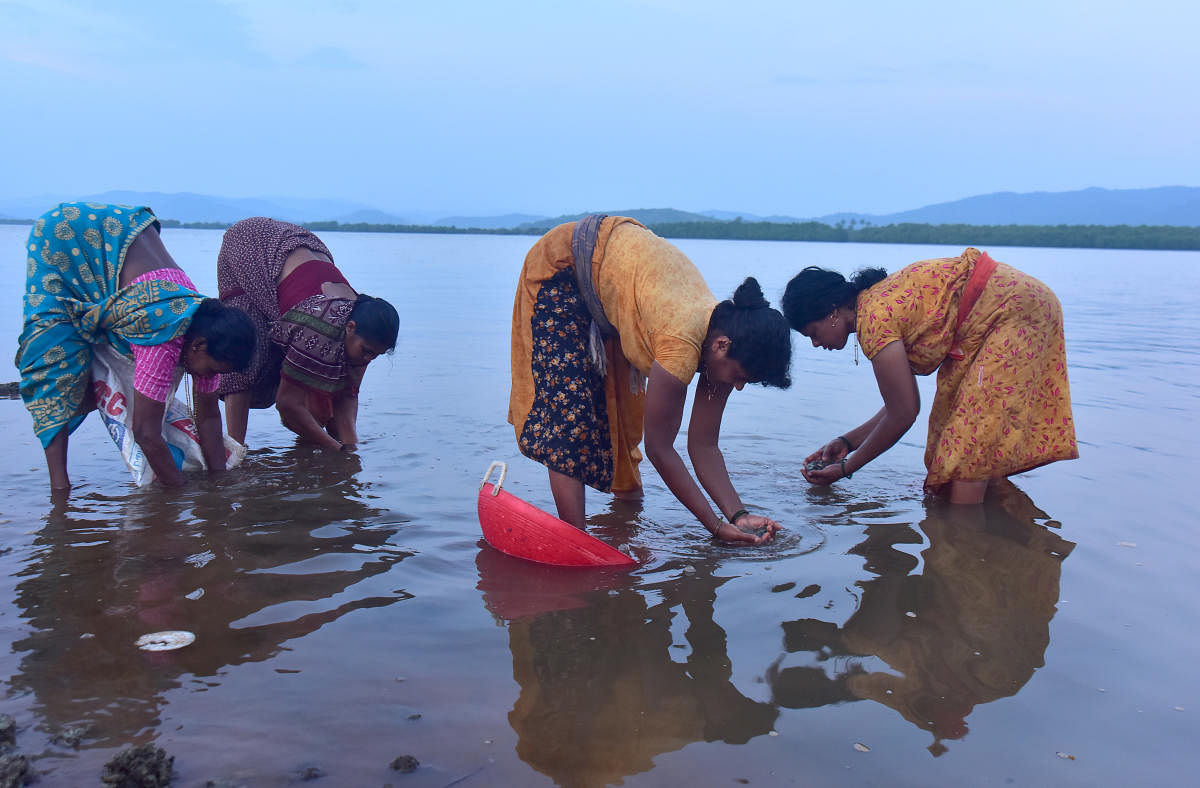Seven years ago, every time there was a low tide in the Arabian Sea near Aghanashini village in Kumta taluk of Uttara Kannada district, almost the entire village would descend on shores to collect bivalves, also known as clams.
Through generations, the molluscan bivalve shellfish of Aghanashini had functioned as a major source of nutrition and livelihood, sustaining up to 4,000 families. But today, the mudflats wear a deserted look as they are depleted of the bounty of bivalves due to overexploitation.
“It’s been almost seven years since we have had any harvest of bivalves in the Aghanashini. A majority of the youth in the village have left their homes in search of alternative work in nearby towns or Goa,” said Santosh Gouda, a former clam digger who is currently working as a manager in a cashew factory in Karwar for Rs 8,000 a month.
“Earlier, every member of the family used to earn at least Rs 400 a day by selling bivalves at local Kumta fish market; and with agriculture being an allied work, we lived a content life. Today, I am the only one in my family who is working and the Rs 8,000 a month that I earn is not enough to make ends meet. We don’t know what resulted in the sudden disappearance of these bivalves,” he said.
Non-sustainable harvesting has not only eliminated the bulk of bivalve resources, an indicator of richness of overall biodiversity of the Aghanashini estuary but also resulted in the migration of clam diggers to urban areas to work as construction labourers or employees in cashew factories and hotels.
“Till the early 2000s bivalves were collected by these families only for their consumption and were considered as poor people’s food. However, as people started realising the nutritious value of these shellfish, the demand for them started growing especially from Goa and surrounding areas,” said M D Subash Chandran, an ecologist with the Indian Institute of Science, Bengaluru. His team has done extensive study on River Aghanashini and its estuary.
According to one such study, it was recorded that in 2008 alone, nearly 18,000 tonnes of bivalves were ‘harvested’ from the estuaries of Aghanashini and transported to Goa in truck loads.
The bivalve collectors would sell one bucket of 10 to 12 kg of bivalves for Rs 100 or Rs 150 in the local market. The star hotels in Goa would sell the same for Rs 200 to Rs 300 per plate of four to six bivalves.
Ramnath Manjunaik, a local trader of clams, said the community did not understand the value of these bivalves till they ‘mysteriously disappeared’ from the river. “Today, when we buy bivalves harvested in Kerala for our consumption for Rs 80 per kg, we are realising that we were big fools.”
Women collectors
More than anything, the bivalves would provide nutrition security to these families. More than men, it was the women who were engaged in large numbers to collect clams from river beds. “Earlier, I had the confidence that my one visit to the river to collect bivalves would ensure two meals. But today, I am just a housewife waiting for my husband and son to send money from town to take care of the house,” said Savitri Pategar (53) of the village.
While the mollusc (meat) was used for dishes, its shell was used in various industries including limestone, paint, chemical, poultry, pharmaceuticals among others, as a rich source of organically sourced calcium.
This demand resulted in the unabated collection of clams from mud beds of the river and the sea. Along with traditional clam digging, where collectors would dive deep (at least 10 to 12 ft) into the sea or river during low tide, mechanised clam mining also began at the estuaries, which resulted in the fast depletion of bivalves.
“The escalating demand for Aghanashini clams from new emerging markets prompted professional clam collectors to trample through fragile mudflats, picking and scooping out every bivalve, irrespective of size, ranging from the tiny juveniles to adults of reproductive age, thereby flouting the very basics of sustainable harvests. Very soon, shell production collapsed in the estuary,” said Subash Chandran.
Kali estuary of Karwar and Sharavathi estuary of Honnavar, in the past, were also good centres of various bivalve species. Most of them witnessed a serious decline due to the construction of large hydroelectric projects upstream, which made serious habitat changes, notably for estuarine bivalves and fishes, on account of dam-related freshwater releases upsetting natural habitats and salinity decline.
“Bivalves are highly sensitive creatures. They survive and reproduce only when there is a right amount of salinity and biomass in the water,” said Subash Chandran and added that the Aghanashini river used to nurture these bivalves by maintaining these parameters until recently.
Experts say that there is a need for further studies to understand the impact of bivalve disappearance from estuaries as these shellfish were part of the food chain for several larger marine fish that would come to the estuaries to complete their reproduction cycle.
Revival efforts
Subash Chandran says there is still hope for the Aghanashini to regain its past glory of being a cradle for bivalves by following in the footsteps of Ashtamudi lake in Kerala.
“A similar situation prevailed in the Ashtamudi estuary of south Kerala, once known for rich fishery and clam bivalve production. In the 1980s and 1990s, the clam fishers indulged in overharvests causing serious stock depletion. Under the initiative of World Wide Fund For Nature India, the Central Marine Fisheries Research Institute and the Kerala State Fishery Department the fishing community organised and adhered to the norms of sustainable fishery, involving restricting the number of fishing days per week, limiting the family-wise harvest quota, and the minimum size of clams to be collected. These steps ensured clam fishery recovered and reached annual sustainable harvests of about 10,000 tonnes per year, of standard size clams, which fetch premium market prices,” he said.
